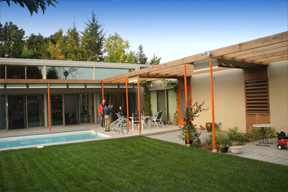This home in Cupertino seemed to have every green and modern feature imaginable. Homeowners David and Stephania are 2 of 3 principles from “Integrated Design Associates, Inc. (IDeAs) is a California and Colorado based consultancy providing electrical engineering and lighting design services for buildings.”
There were many exceptional green technologies used, but when it came to lighting, the home was even more advanced. Compact fluorescents, Leds, motion sensors were used as well as a whole wall of glass – over 1200 sq. ft of windows along the south wall. These windows provided daylighting as well as passive solar heat features.
David was a client and friend of Bill Leddy, principle of LMS architects LMSarch.com in San Francisco, CA, so when he and Stephania decide to build their home, there was no other choice but to use this award-winning architect.
The homeowners, architect, and builder, collaborated at the beginning of the project and were able to build a LEED Platinum, Zero Carbon home. In addition to the LEED standard, the home uses no carbon based fuels and is meant to use only as much energy as it produces.
To complement the Passive Solar, the home has motorized blinds installed outside, keeping the inside cool in the warmer months. When the temperature outside gets colder, they can be opened to let the sun’s warmth in. The concrete slab floors are a thermal mass, also helping to keep the home cooler in the spring and summer, then allow the sun to warm the floors during the cooler winter months.
In addition to the passive solar, the 2,400 sq. ft. home was designed to be heated from a Solar Thermal system that also uses the additional summer heat for the in-ground pool – acting as a heat sink – in addition to supplying the families hot water.
A Daikin Altherma Air source heat pump daikinac.com provides additional heating when needed, without burning fossil fuels and is said to work better than any air conditioner for cooling.
My personal favourite was their Induction Cook-Top. Stephania and David have a very high-end and expensive product, but as these appliances have become more popular, other companies have seen the value and have been coming out with their own lower cost models.
These cook-tops are simply amazing. Induction cookers are faster and more energy-efficient than a traditional electric cook-top; moreover, they heat up instantly, unlike the conventional electric element that takes time to heat, longer if you are watching the kettle boil. 🙂 In fact, a traditional range or cooktop can take 9 minutes to boil water, while the Induction model can take a little as 4 minutes, using half the energy.
An induction cooktop uses a type of induction heating or electrical magnetism for cooking. Heat is generated directly in the pot as opposed to being generated in the stove top and uses a magnetic field to create this heat.
Stephania told me that her cook-top would boil water extremely fast, yet you could take a pot off and the element would be cool. She showed us how you could put a cloth on the burner and then heat a pot of water over this, never burning the cloth. Stephania prefers to cook with a Wok and in this particular model it was built-in, creating a perfect fit for this family of four.
In addition to the other green elements in the home, the wood framing, doors, trim, cabinets and shelves are FSC certified, having no added formaldehyde in the finishes. Most of the custom cupboards were made of bamboo, known to be fast growing. Bamboo is a type of grass rather than a tree and matures in 4 to 5 years.
The homeowners also installed a Grey Water system. Water from the tubs, showers and sinks of the home is used to water the plants in the back. David did mention that they needed an additional solution for when the family is away for an extended period of time. Even when the family is at home, the low flow plumbing fixtures don’t create a huge amount of waste water for the gardens, so the back yard was dryer than it needed to be.
This home is a very modern build and great example of several advanced technologies. David and Stephania should be able to enjoy living in this home for years to come, with low utility bills, allowing the sun to power and heat their home. Their home serves as a great example of new build technologies and will help further green building into the future.
ps. Integrated Design Associates, Inc. (IDeAs) has recently become part of Integral Group. An interactive global network of design professionals collaborating under a single deep green engineering umbrella. Congratulations Stephania and David.








It’s wonderful to have you on our side, haha!